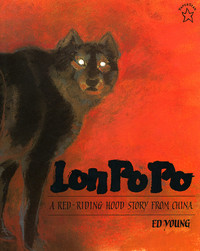Lon Po Po
 | |
| Author | Ed Young |
|---|---|
| Illustrator | Ed Young |
| Cover artist | Samantha |
| Country | China |
| Language | English |
| Genre | Children's picture book |
| Publisher | Philomel |
Publication date | November 1989 |
| Media type | Print (Hardcover and Paperback) |
| Pages | 32 (first edition, hardback) |
| ISBN | 978-0-399-21619-0 |
| OCLC | 17981442 |
| 398.2/0951 E 19 | |
| LC Class | PZ8.1.Y84 Lo 1989 |
Lon Po Po: A Red-Riding Hood Story from China is a children's picture book translated and illustrated by Ed Young. It was published by Philomel (Penguin Young Readers Group) in 1989. Young won the 1990 Caldecott Medal for the book's illustrations.
Description[]
The story is a Chinese version of the popular children's fable "Little Red Riding Hood" as retold by Young. Contrary to the original fable, in which there is only one child (Little Red Riding Hood) who interacts with the nemesis of the story (the wolf), Lon Po Po has three children. It is written from their point of view. The majority of the illustrations are divided into three pictures per every two pages to form a bigger picture (with a few exceptions). Young uses dark colors for the illustrations to set the tone of the story.
Synopsis[]
The story is set in China. Three sisters, Shang, Tao, and Paotze are left alone overnight while their mother goes to visit their grandmother Po Po's house for her birthday. Before leaving, the mother warns the girls to "Be good" and "Remember to close the door tight at sunset and latch it well". Meanwhile, an old wolf sees the mother leave and decides to come over to harm the children. The wolf pretends to be their grandmother, Po Po, to try to gain entry. The children question the wolf through the door, "Why are you here so late?" and "Why is your voice so low?", to which the wolf has clever answers. The two youngest children finally open the door and let the wolf in. Because of the darkness, the children can't see that it is a wolf. When it is time for bed, the children and the wolf are to sleep together. The children notice "Po Po's" wolflike characteristics. They question him like "Po Po, your foot has a bush on it", "Po Po, your hands have thorns" to which the wolf has more clever answers. Finally, Shang (the oldest) lights a candle and before it gets blown out, sees that Po Po is really a wolf. She devises a plan to get herself and her sisters out of the house. She tells the wolf about the delicious, magical gingko nuts that grow on the tree outside their home. The children go out and climb the tree where she tells the other two who Po Po really is, while the wolf follows. They tell the wolf to get a rope and a basket so they can pull him up the tree to get the nuts, all the while planning on dropping the wolf once in the basket. When they dropped the basket, the wolf bumped his head. On the third time as the wolf reaches for the nuts, the kids let go of the rope, sending the wolf plummeting once more, killing him on impact. Not only did the wolf bump his head, but he broke into pieces. The girls then ask the wolf if he is okay, but they hear no answer because the wolf had died from the fall. And that night, after seeing the wolf's broken and dead body (now in pieces), the girls then go inside the house, lock the door, and go to bed. After the mother's return the next day they tell her what happened.
Audiobook[]
Young's version was made into a critically acclaimed audiobook that was released in 2006. It was made into a 12-minute-long audiobook and colored video and DVD by Weston Woods Studios. It is narrated by actor B. D. Wong.
Critical response[]
Lon Po Po has been critically acclaimed. Barbara Auerbach of the School Library Journal wrote "The shadows and cautious, frightened faces coupled with the narrator's expressive storytelling will leave viewers on the edge of their seats"[1] Heather McNeil (Horn Book Magazine): "This production brings new life to an old favorite."[2]
The text possess that matter of fact veracity that characterizes the best fairy tales... The water color and pastel pictures are remarkable...Overall, this is an outstanding achievement that will be pored over again and again....
- —John Philbrook, San Francisco Pub. Lib. (School Library Journal)[3]
References[]
- ^ Auerbach, Barbara. "Lon Po Po". School Library Journal 52.8 (2006): 49–50. Academic Search Complete. Web. 24 Nov. 2014.
- ^ McNeil, Heather. "Lon Po Po". Horn Book Magazine (2007): 304. Academic Search Complete. Web. 24 Nov. 2014.
- ^ "Lon Po Po (Book)". School Library Journal 35.16 (1989): 97. Academic Search Complete. Web. 24 Nov. 2014.
- American picture books
- Children's fiction books
- Caldecott Medal-winning works
- 1989 children's books
- Picture books based on fairy tales
- Works based on Little Red Riding Hood
- Children's books about China
- Books about wolves
- Chinese-American literature